
Brandon Ralph (born 1979)
50 Stars & International Newsprint I, 2024
View Bio
As a contemporary artist, Ralph uses photography, sculpture, and drawing to explore the complexities of life and cultural coexistence within his projects, as embodied in The American Experiment. Ralph’s art invites spectators to revisit and re-evaluate their experience through his own, offering a glimpse of how to persevere through life’s challenges with humor and irony, and creating a dialogue that reflects the intricacy of everyday existence. Brandon Ralph’s perspective was shaped by the juxtaposition of his mother’s unwavering belief in the American Dream and the harsh reality of growing up on welfare along with learning disabilities.
In his sculptural depictions of the American flag, Ralph explores the physical object and its symbolism, both the very essence of our nation’s identity. By working with papier-mâché crafted from international newspapers, he highlights the diversity that literally and figuratively holds the fabric of America together. Each fragment of newsprint reflects the strength and resilience derived from the myriad cultures and perspectives that comprise our nation. These flags stand not only as a symbol of patriotism but as a testament to the powerful role every citizen plays in shaping and sustaining the American spirit, an ever-changing and evolving ideal that asks each of us to live with an empathetic, adaptable, and open-minded view toward all.
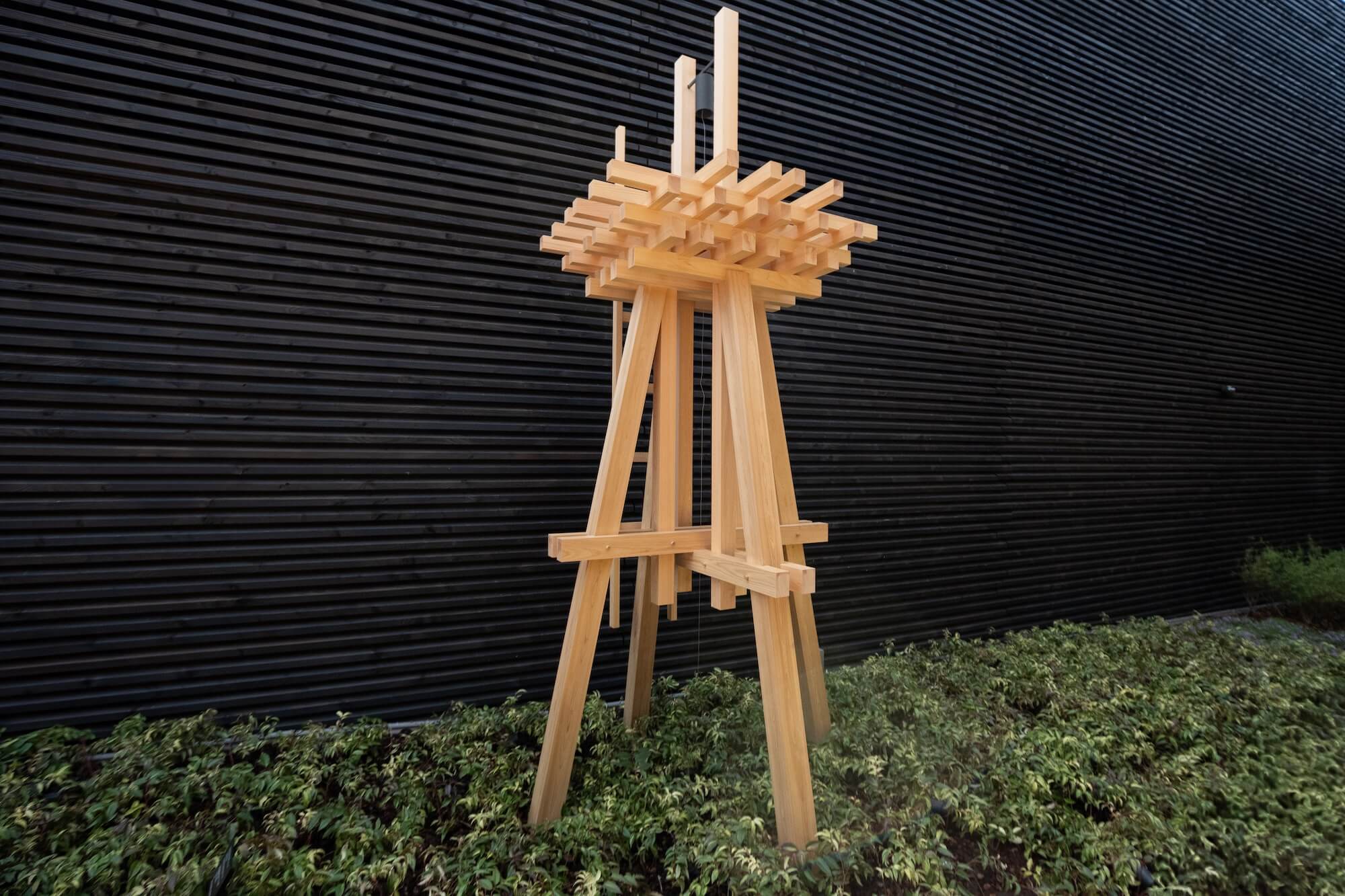
Megumi Aihara, Dan Spiegel, & Tamotsu Teshima
Looking, After the Fires
Courtesy of Spiegel Aihara Workshop, Inc., and Tamotsu Teshima Architect & Associates
“Looking, After the Fires” is an exploration of cultural responses to fire and wildfires in American and Japanese cultures, and a speculation on how we might better understand fire in our lives.
Although fire has the potential to devastate landscapes and communities, it also has the power to rebalance the natural environment and promote regeneration. We seek to explore this conflict between destruction and rebirth, symbolizing hope beyond overcoming difficulties.
Drawing from vernacular fire lookout towers in the United States and Japan, this installation provides a vantage point from which to view our environment anew – both the dangers and the opportunities for regeneration and renewal.
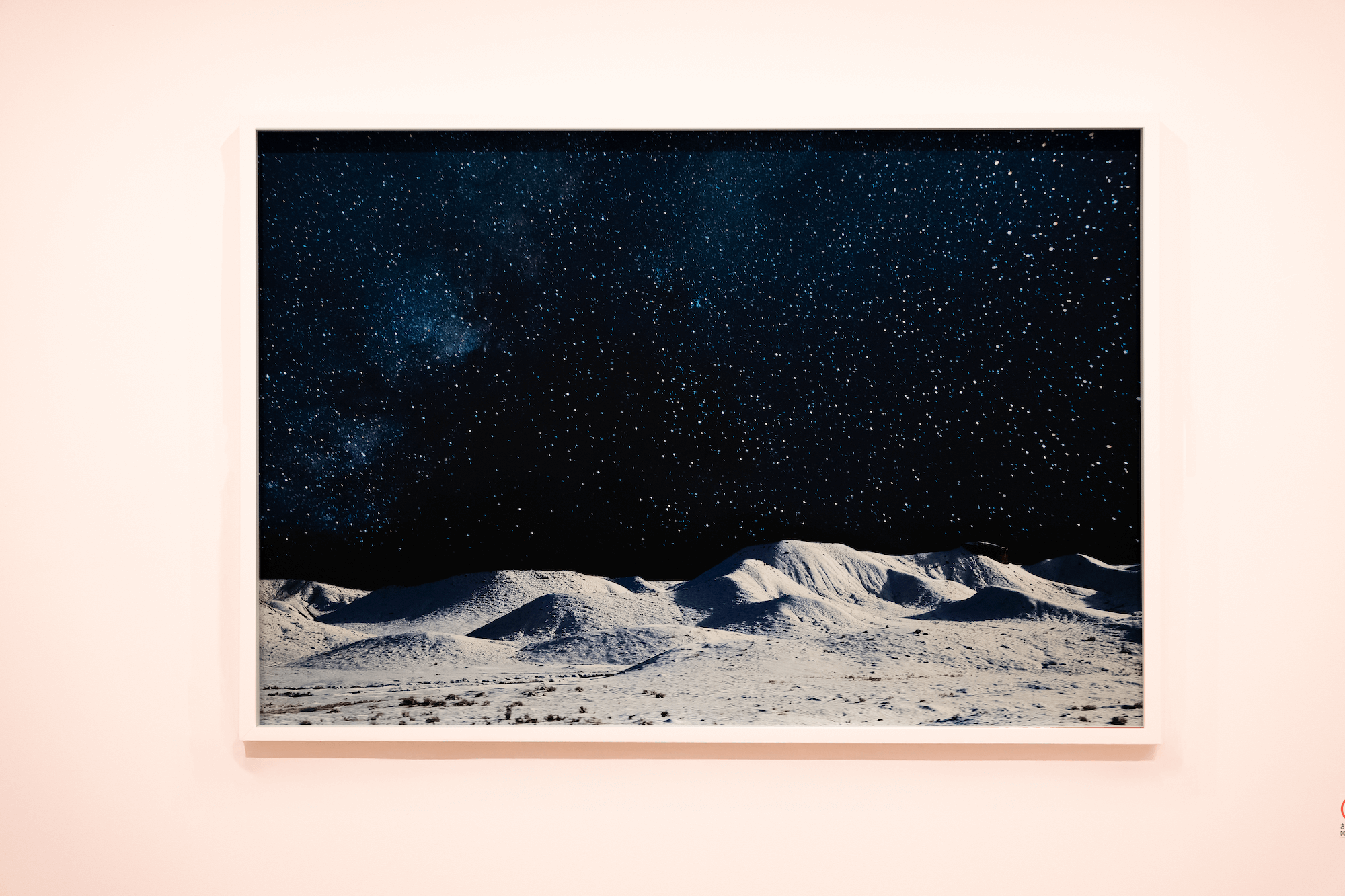
Luciana Abait (born 1971)
Galaxy, 2019 from Road Trip Series
Photograph and acrylic painting on Hahnemühle etching paper
Courtesy of the artist, Santa Monica, California
View Bio
Los Angeles-based multimedia artist Luciana Abait immigrated to the United States from Argentina. Red Mountain – Blue Sky and Galaxy from Abait’s Road Trip Series showcases photographs the artist took on a road trip through the American West with added acrylic paint on etching paper. In this series, Abait uses the American landscapes to examine an ever-changing world and her pursuit of the feeling of home amidst this change.
Abait’s artworks have been shown widely in the United States, Europe, Latin America and Asia in solo exhibitions in museums, including Hilliard Art Museum, Louisiana, Laguna Art Museum, California. Her work in the collections of the Miami-Dade Public Library System, Lehigh University Museum and West Collection in Pennsylvania; Flint Institute of Arts in Michigan; the Board of Governors of the Federal Reserve System in Washington D.C
Artist website: www.lucianaabait.com
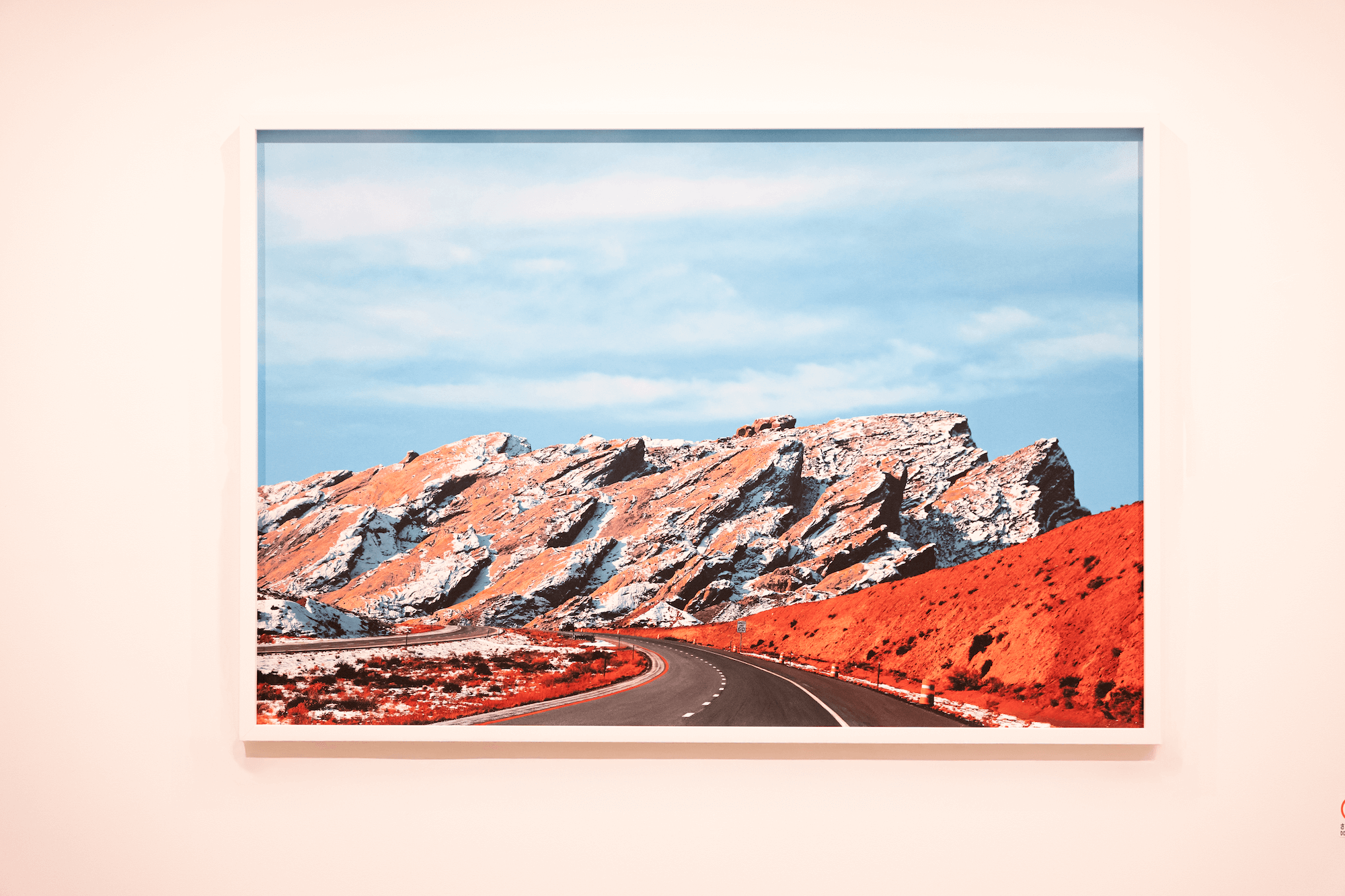
Luciana Abait (born 1971)
Red Mountain - Blue Sky, 2019 from Road Trip Series
Photograph and acrylic painting on Hahnemühle etching paper
Courtesy of the artist, Santa Monica, California
View Bio
Los Angeles-based multimedia artist Luciana Abait immigrated to the United States from Argentina. Red Mountain – Blue Sky and Galaxy from Abait’s Road Trip Series showcases photographs the artist took on a road trip through the American West with added acrylic paint on etching paper. In this series, Abait uses the American landscapes to examine an ever-changing world and her pursuit of the feeling of home amidst this change.
Abait’s artworks have been shown widely in the United States, Europe, Latin America and Asia in solo exhibitions in museums, including Hilliard Art Museum, Louisiana, Laguna Art Museum, California. Her work in the collections of the Miami-Dade Public Library System, Lehigh University Museum and West Collection in Pennsylvania; Flint Institute of Arts in Michigan; the Board of Governors of the Federal Reserve System in Washington D.C
Artist website: www.lucianaabait.com
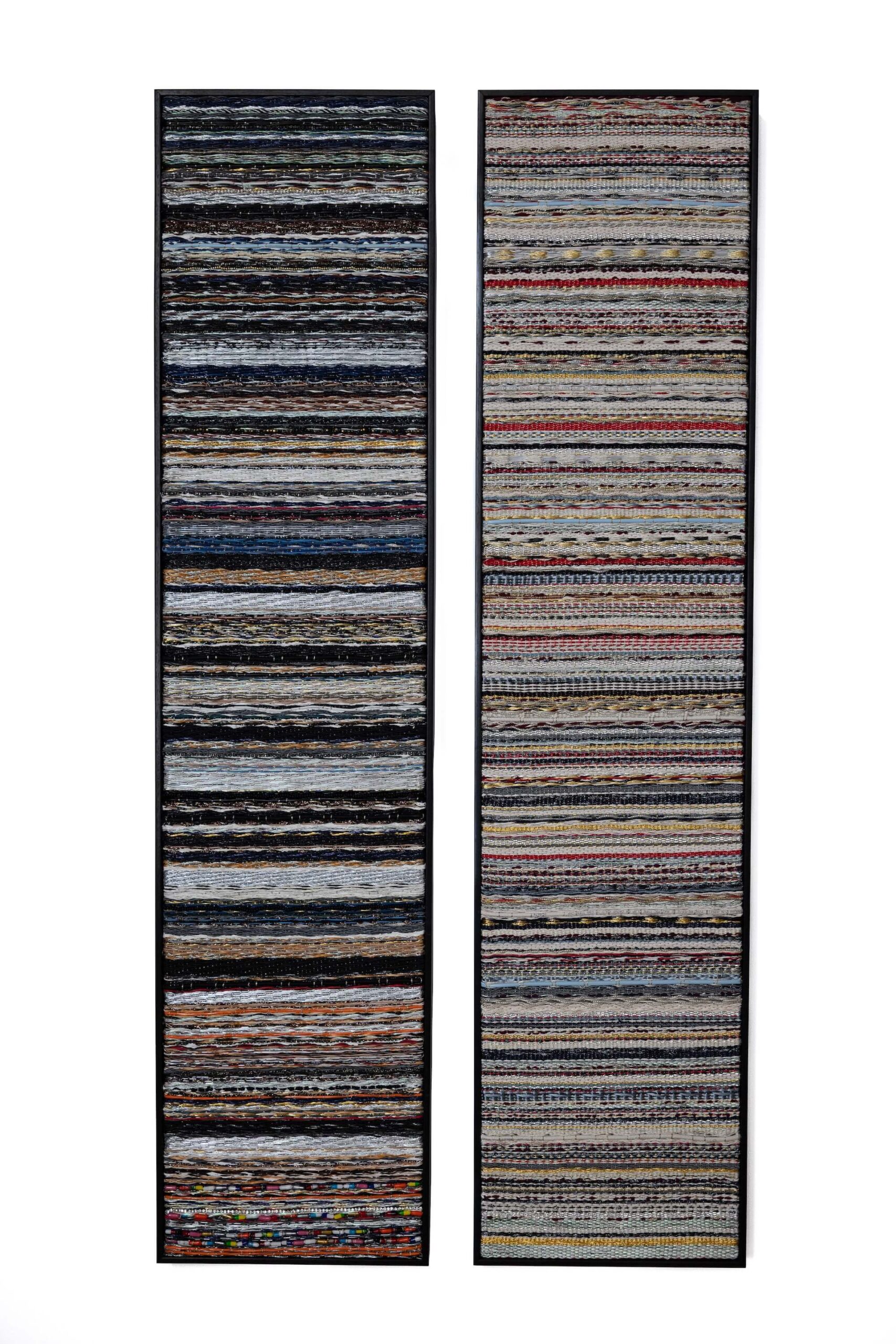
Sebastien Courty (born 1991)
American Totem, 2025
Recycled plastic, leather, gold thread, rubber, coated thread, paper, acrylic thread, aluminum, cables, rhinestone chain, beads, spray painted threads
Courtesy of the artist, Syracuse, New York
View Bio
Textile artist Sebastien Courty grew up in France and was surrounded by handcraft and art from an early age. The artist has been based in New York City since 2012 and founded his own Textile Art Studio in 2018 in Brooklyn. Using traditional craftmanship techniques such as hand weaving. Japanese Totem and American Totem are part of Courty’s collection “Totem, A Wall’s Jewelry” which takes inspiration from the natural resources, commercial activities, and rich traditions of each country, these two artworks explore the shared values and distinct differences that define their cultural landscapes. Courty envisions each textile panel in this collection as “a window into a community.”
Artist website: www.sebastiencourty.com

Sebastien Courty (born 1991)
Japanese Totem, 2025
Recycled plastic, leather, gold thread, rubber, coated thread, paper, acrylic thread, aluminum, cables, rhinestone chain, beads, spray painted threads
Courtesy of the artist, Syracuse, New York
View Bio
Textile artist Sebastien Courty grew up in France and was surrounded by handcraft and art from an early age. The artist has been based in New York City since 2012 and founded his own Textile Art Studio in 2018 in Brooklyn. Using traditional craftmanship techniques such as hand weaving. Japanese Totem and American Totem are part of Courty’s collection “Totem, A Wall’s Jewelry” which takes inspiration from the natural resources, commercial activities, and rich traditions of each country, these two artworks explore the shared values and distinct differences that define their cultural landscapes. Courty envisions each textile panel in this collection as “a window into a community.”
Artist website: www.sebastiencourty.com
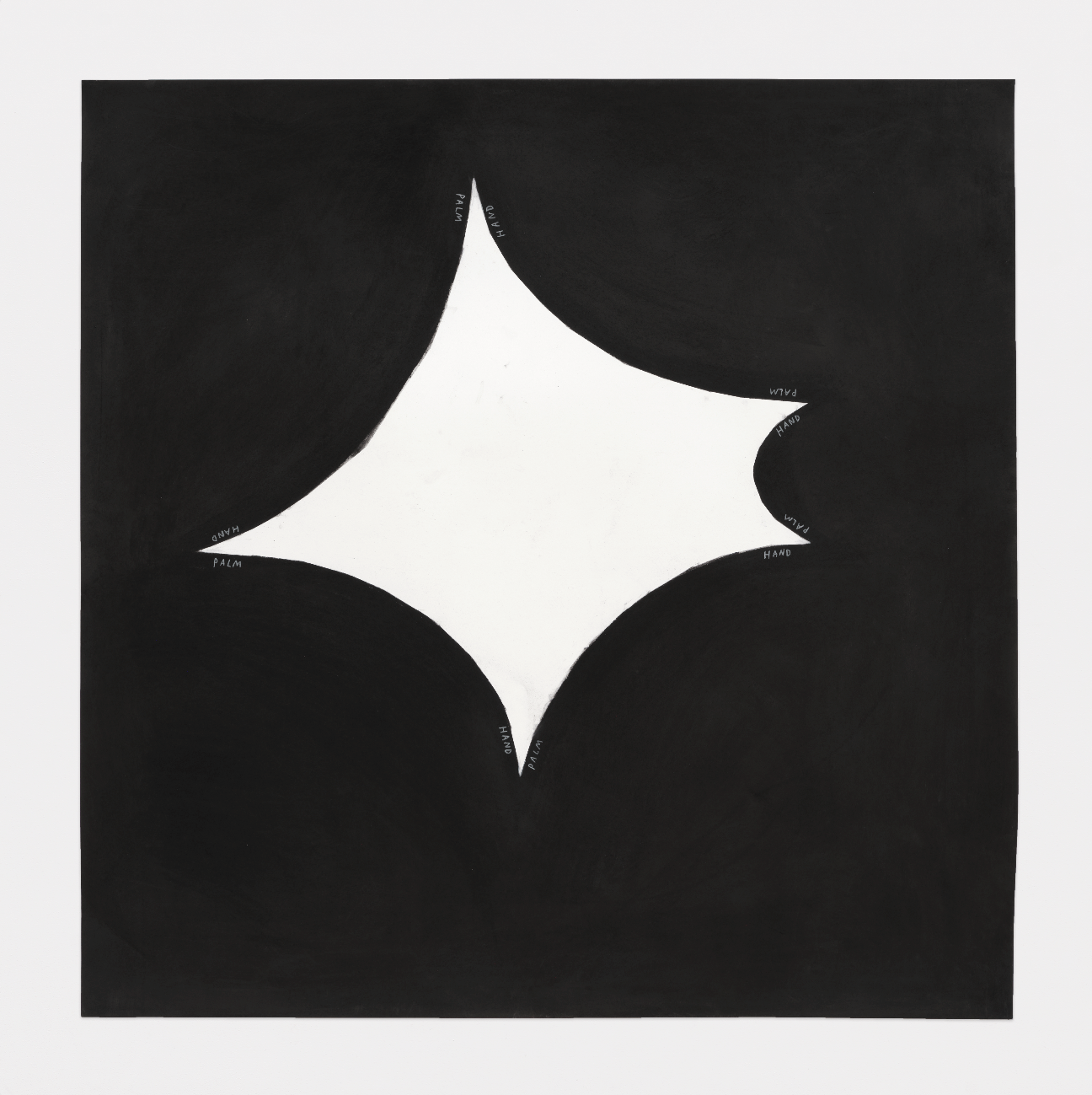
Christine Sun Kim (born 1980)
Echo Trap, 2022
Charcoal on paper
Courtesy of the artist and François Ghebaly,
Los Angeles, California
View Bio
Christine Sun Kim’s practice considers how sound operates in society. Musical notation, written language, infographics, American Sign Language (ASL), the use of the body, and strategically deployed humor are all recurring elements in her practice. Working across drawing, performance, video and large-scale murals, Kim explores her relationship to spoken and signed languages, to her built and social environments, and to the world at large. Kim’s work has been extensively exhibited and performed internationally. Her works are held in numerous prominent collections, including the Museum of Modern Art, New York, LACMA, Tate Britain, Smithsonian American Art Museum, Museum of Contemporary Art, Los Angeles, and the Whitney Museum of American Art, among others.
Artist website: www.christinesunkim.com
Gallery website: https://ghebaly.com/artists/christine-sun-kim/
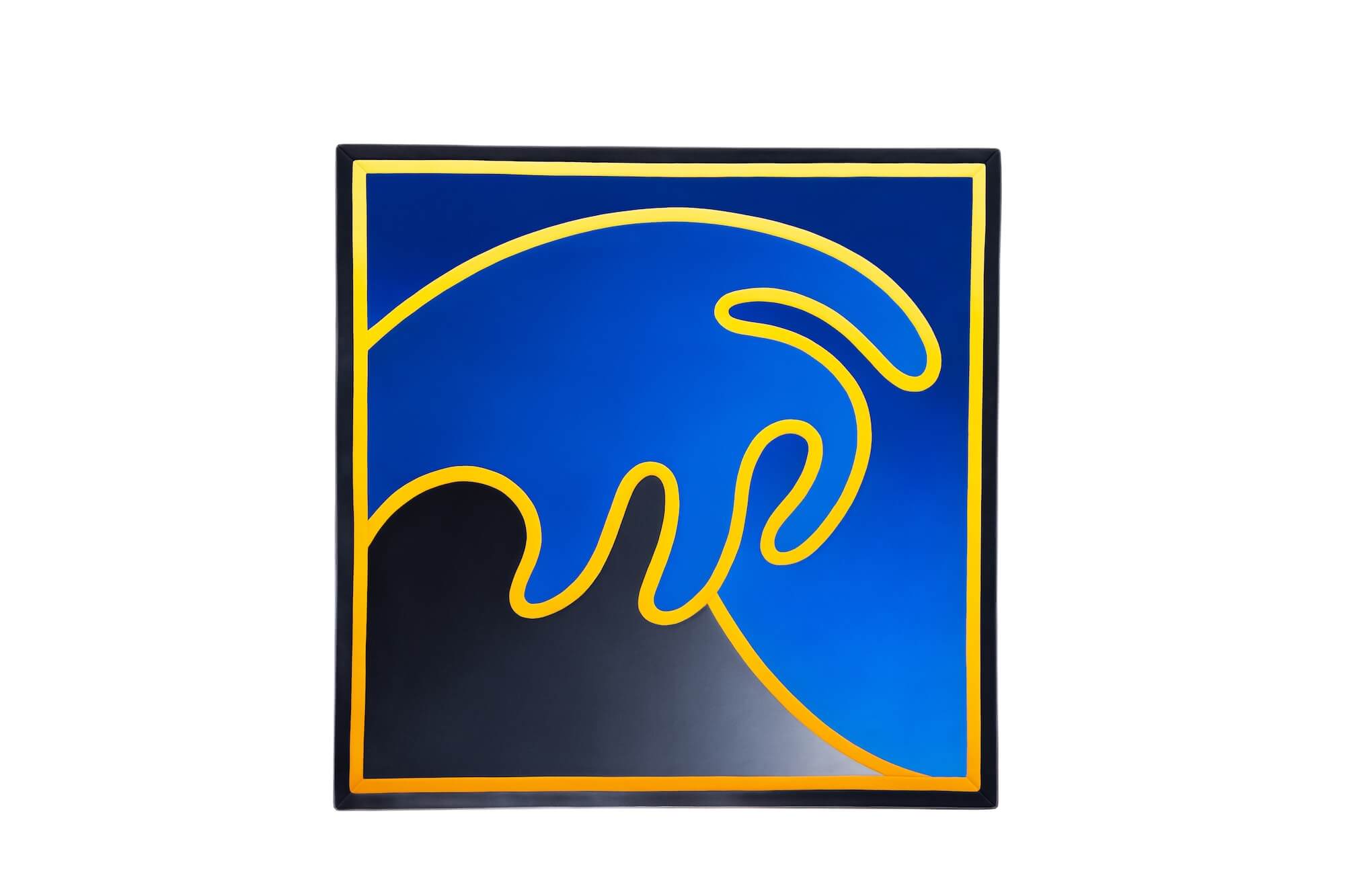
Alex Israel (born 1982)
Wave, 2018
Acrylic on fiberglass
Courtesy of the artist and François Ghebaly,
Los Angeles, California
View Bio
Los Angeles-based artist Alex Israel has been deeply influenced by the art and culture of his hometown. In his paintings, sculptures, and installations, Israel uses the iconography of Los Angeles to explore American culture and the American dream. The artist’s explorations of his evolving dialogue with contemporary culture is a journey through the landscape of modern culture. Inspired by Katsushika Hokusai ‘s work, The Great Wave of Kanagawa, which captures the formidable power of nature with the iconic woodblock print, featuring frothy, claw-like waves ready to engulf the boats beneath Mount Fuji, Israel’s ‘Wave’ offers a modern, informal iteration. Rendered in pastel gradients, it evokes the culture of contemporary California. Alex Israel’s work can be found in numerous museum collections worldwide, including the Museum of Modern Art (MoMA), the Whitney Museum of American Art, the Los Angeles County Museum of Art (LACMA), and the Centre Pompidou in Paris.
Gallery website: https://gagosian.com/artists/alex-israel/

Lara Knutson (born 1974)
Zinnia, 2023
Glass, fabric, wood veneer, powder-coated steel, LEDs
Courtesy of the artist, Brooklyn, New York
View Bio
Lara Knutson is an artist, industrial designer and architect based in New York City. Born in Beach Haven, New Jersey, Knutson grew up observing light glowing and reflecting in the natural world such as in fish scales, seashells, water, and the night sky. Knutson’s fascination with light can be seen in her work Zinnia, which creates the illusion of a three-dimensional floating flower of light and is named after the first flower grown in space. NASA grew zinnia flowers in aboard the International Space Station (ISS) to study how plants grow in microgravity and to explore the possibility of growing fresh food on long-duration missions. Knutson’s new way of making light appears three dimensional and mix color in space, it looks like something that can be touched.
Knutson was among the Artists featured in the exhibit “”40 Under 40: Craft Futures”” at the Renwick Gallery of the Smithsonian Museum of American Art, and one of her pieces was acquired by the museum. She also has a piece in the permanent collection of the Corning Museum of Glass. Her jewelry has been featured on the cover of the Museum of Modern Art’s design store catalog
Artist Website: www.laraknutson.com
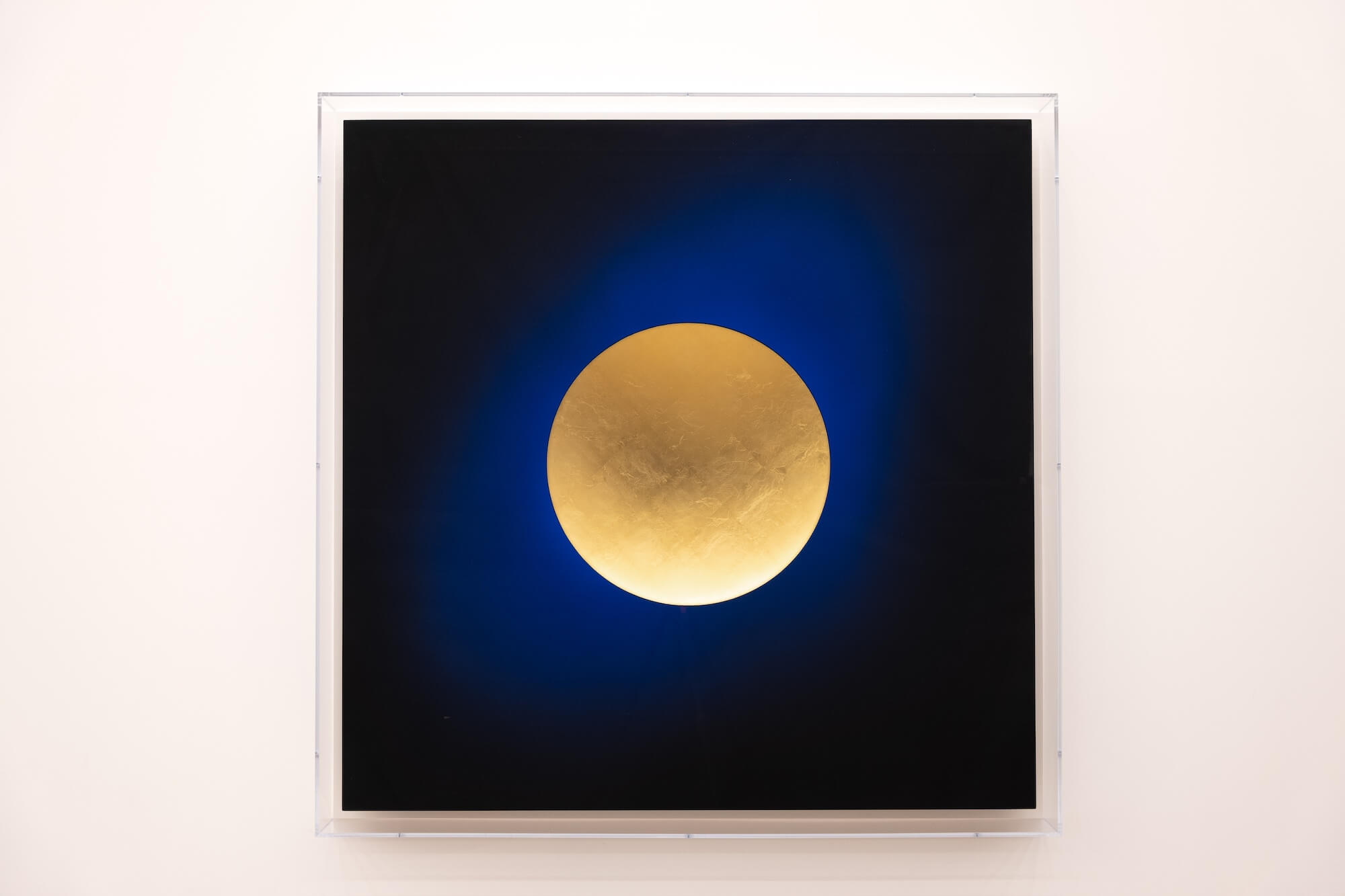
Lita Albuquerque (born 1946)
Solar Flash (Gold au2), 2024
24-karat gold on resin, pigment on panel
Courtesy of the artist and Peter Blake Gallery,
Laguna Beach, California
View Bio
Lita Albuquerque is an internationally renowned multi-disciplinary artist. Her work questions the human connection to the cosmos and often involves themes of light, space, and time. In the 1970s, Albuquerque emerged as a leading figure of the Light and Space movement, a group of California artists who explored the relationship between geometric shapes, light, and the environment and the perception of the viewer. Albuquerque’s work, Solar Flash (Gold au2), (24kt Gold on resin, pigment on panel) visualizes the earth as a sculpture moving in space and questions what the earth might look like from the Particle Horizon, at the furthest point that can be seen by the human eye.
Albuquerque’s work is in the collections of the Metropolitan Museum of Art, the Whitney Museum of American Art, Los Angeles County Museum of Art, Museum of Contemporary Art, The J. Paul Getty Trust
Artist website: www.litaalbuquerque.com
Gallery website: www.peterblakegallery.com
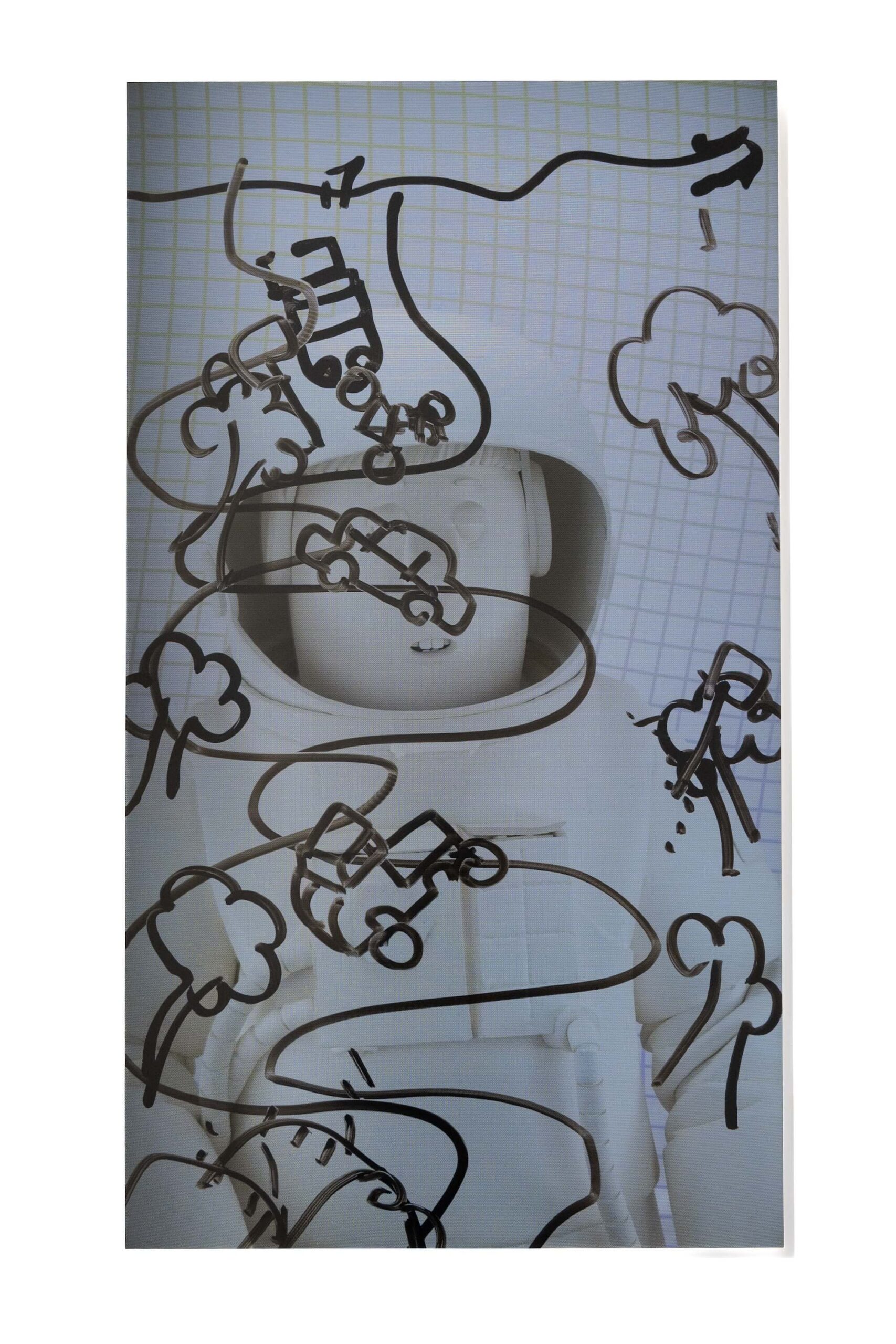
Brian Bress (born 1975)
Astronaut (Pat on gradient grid), 2018
High definition single-channel video (color), high definition monitor and player
Courtesy of the artist and Philip Martin Gallery,
Los Angeles, California
View Bio
Brian Bress is a multimedia artist based in Los Angeles who creates videos to address the connections between film, photography and painting, and the two-dimensional picture plane these mediums share. Bress’s works have been described as “animated paintings” and Bress has said that he approaches video with the agenda of a painter. In Boris on blue hills, a bulky astronaut draws a marker sketch of a car on the glass, a playful reimagining of an astronaut’s standard mode of transport.
Bress’s work is in the collections of the Utah Museum of Fine Arts, Hammer Museum Los Angeles, CA, Los Angeles County Museum of Art, Museum of Art, Chicago, IL and the Whitney Museum of American Art, among others.
Artist website: brianbress.com
Gallery website: www.philipmartingallery.com

Sheila Hicks (born 1934)
We Are at The Gate, 2025
Linen, cotton, pure pigment acrylic fiber
Courtesy of the artist and Sikkema Malloy Jenkins Gallery, New York, New York
View Bio
Sheila Hicks is one of the leading fiber artists in the world. The artist uses a range of materials to explore structure, form, and color in creating her textile installations. Hicks has been inspired by weaving cultures from around the world and is known for her innovative and experimental textile artworks that incorporate distinctive colors, natural materials, and personal narratives. Hicks’ work is in the permanent collections of The Art Institute of Chicago, IL; The Centre Pompidou, Paris; The Jewish Museum, New York, NY; Louis Vuitton Foundation, Paris; The Metropolitan Museum of Art, New York, NY; Museo de Bellas Artes, Santiago; The Museum of Modern Art, New York, NY; Museum of Modern Art, Tokyo; The National Gallery of Art, Washington, D.C.; the Pérez Art Museum, Miami, FL; Stedelijk Museum, Amsterdam; and Tate Britain, London, among many others.
Artist website: www.sheilahicks.com
Gallery website: www.smjny.com

Josh Simpson (born 1949)
Corona Stellar Disc I, 2019 Blown glass
Courtesy of the artist,
Shelburne Falls, Massachusetts
View Bio
Glass artist Josh Simpson has been creating space-inspired glass art for over 50 years. He was originally inspired by the photo of the earth taken by the crew of the Apollo 17 in 1972 which inspired him to create the glass “Megaplanets”. Simpson has said that glass has captivated him for so long because it spans many of his interests including color, form, contrast, iridescence, tessellating patterns, and high temperature chemistry. Simpson’s Stellar Discs evoke swirling seas, star-filled night skies, distant nebulae, colliding stars, and other astronomical events.
Simpson’s glass can be found in the collections of the Corning Museum of Glass, the Museum of Fine Arts, Boston, and the Smithsonian Renwick Gallery, Washington, DC.
Artist website: www.joshsimpsonglass.com
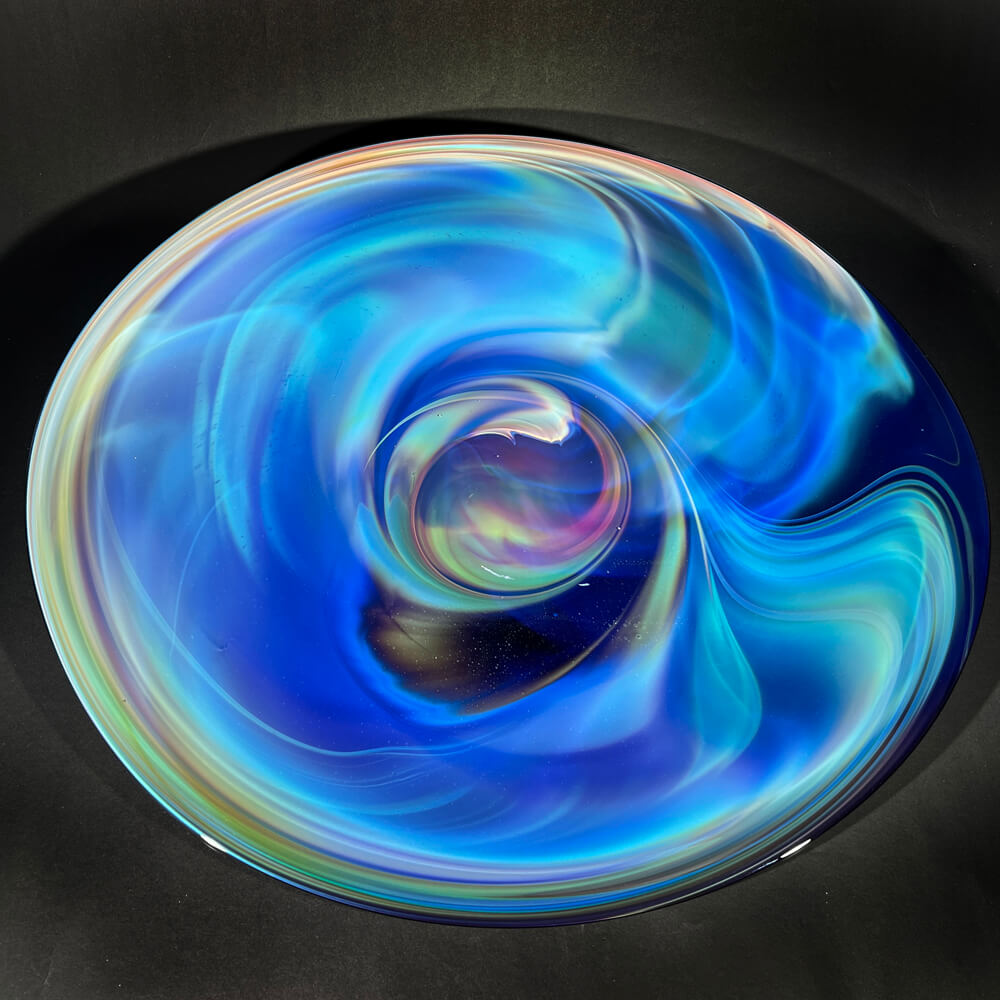
Josh Simpson (born 1949)
Corona Stellar Disc II, 2016 Blown glass
Courtesy of the artist,
Shelburne Falls, Massachusetts
View Bio
Glass artist Josh Simpson has been creating space-inspired glass art for over 50 years. He was originally inspired by the photo of the earth taken by the crew of the Apollo 17 in 1972 which inspired him to create the glass “Megaplanets”. Simpson has said that glass has captivated him for so long because it spans many of his interests including color, form, contrast, iridescence, tessellating patterns, and high temperature chemistry. Simpson’s Stellar Discs evoke swirling seas, star-filled night skies, distant nebulae, colliding stars, and other astronomical events.
Simpson’s glass can be found in the collections of the Corning Museum of Glass, the Museum of Fine Arts, Boston, and the Smithsonian Renwick Gallery, Washington, DC.
Artist website: www.joshsimpsonglass.com

Josh Simpson (born 1949)
Corona Stellar Disc III, 2023 Blown glass
Courtesy of the artist,
Shelburne Falls, Massachusetts
View Bio
Glass artist Josh Simpson has been creating space-inspired glass art for over 50 years. He was originally inspired by the photo of the earth taken by the crew of the Apollo 17 in 1972 which inspired him to create the glass “Megaplanets”. Simpson has said that glass has captivated him for so long because it spans many of his interests including color, form, contrast, iridescence, tessellating patterns, and high temperature chemistry. Simpson’s Stellar Discs evoke swirling seas, star-filled night skies, distant nebulae, colliding stars, and other astronomical events.
Simpson’s glass can be found in the collections of the Corning Museum of Glass, the Museum of Fine Arts, Boston, and the Smithsonian Renwick Gallery, Washington, DC.
Artist website: www.joshsimpsonglass.com

Josh Simpson (born 1949)
New Mexico Saturn, 2021 Blown glass
Courtesy of the artist,
Shelburne Falls, Massachusetts
View Bio
Glass artist Josh Simpson has been creating space-inspired glass art for over 50 years. He was originally inspired by the photo of the earth taken by the crew of the Apollo 17 in 1972 which inspired him to create the glass “Megaplanets”. Simpson has said that glass has captivated him for so long because it spans many of his interests including color, form, contrast, iridescence, tessellating patterns, and high temperature chemistry. Simpson’s Stellar Discs evoke swirling seas, star-filled night skies, distant nebulae, colliding stars, and other astronomical events.
Simpson’s glass can be found in the collections of the Corning Museum of Glass, the Museum of Fine Arts, Boston, and the Smithsonian Renwick Gallery, Washington, DC.
Artist website: www.joshsimpsonglass.com

Josh Simpson (born 1949)
New Mexico Disc, 2023 Blown glass
Courtesy of the artist,
Shelburne Falls, Massachusetts
View Bio
Glass artist Josh Simpson has been creating space-inspired glass art for over 50 years. He was originally inspired by the photo of the earth taken by the crew of the Apollo 17 in 1972 which inspired him to create the glass “Megaplanets”. Simpson has said that glass has captivated him for so long because it spans many of his interests including color, form, contrast, iridescence, tessellating patterns, and high temperature chemistry. Simpson’s Stellar Discs evoke swirling seas, star-filled night skies, distant nebulae, colliding stars, and other astronomical events.
Simpson’s glass can be found in the collections of the Corning Museum of Glass, the Museum of Fine Arts, Boston, and the Smithsonian Renwick Gallery, Washington, DC.
Artist website: www.joshsimpsonglass.com

Josh Simpson (born 1949)
Megaplanet, 2005 Solid glass sphere
Courtesy of the artist,
Shelburne Falls, Massachusetts
View Bio
Glass artist Josh Simpson has been creating space-inspired glass art for over 50 years. He was originally inspired by the photo of the earth taken by the crew of the Apollo 17 in 1972 which inspired him to create the glass “Megaplanets”. Simpson has said that glass has captivated him for so long because it spans many of his interests including color, form, contrast, iridescence, tessellating patterns, and high temperature chemistry. Simpson’s Stellar Discs evoke swirling seas, star-filled night skies, distant nebulae, colliding stars, and other astronomical events.
Simpson’s glass can be found in the collections of the Corning Museum of Glass, the Museum of Fine Arts, Boston, and the Smithsonian Renwick Gallery, Washington, DC.
Artist website: www.joshsimpsonglass.com
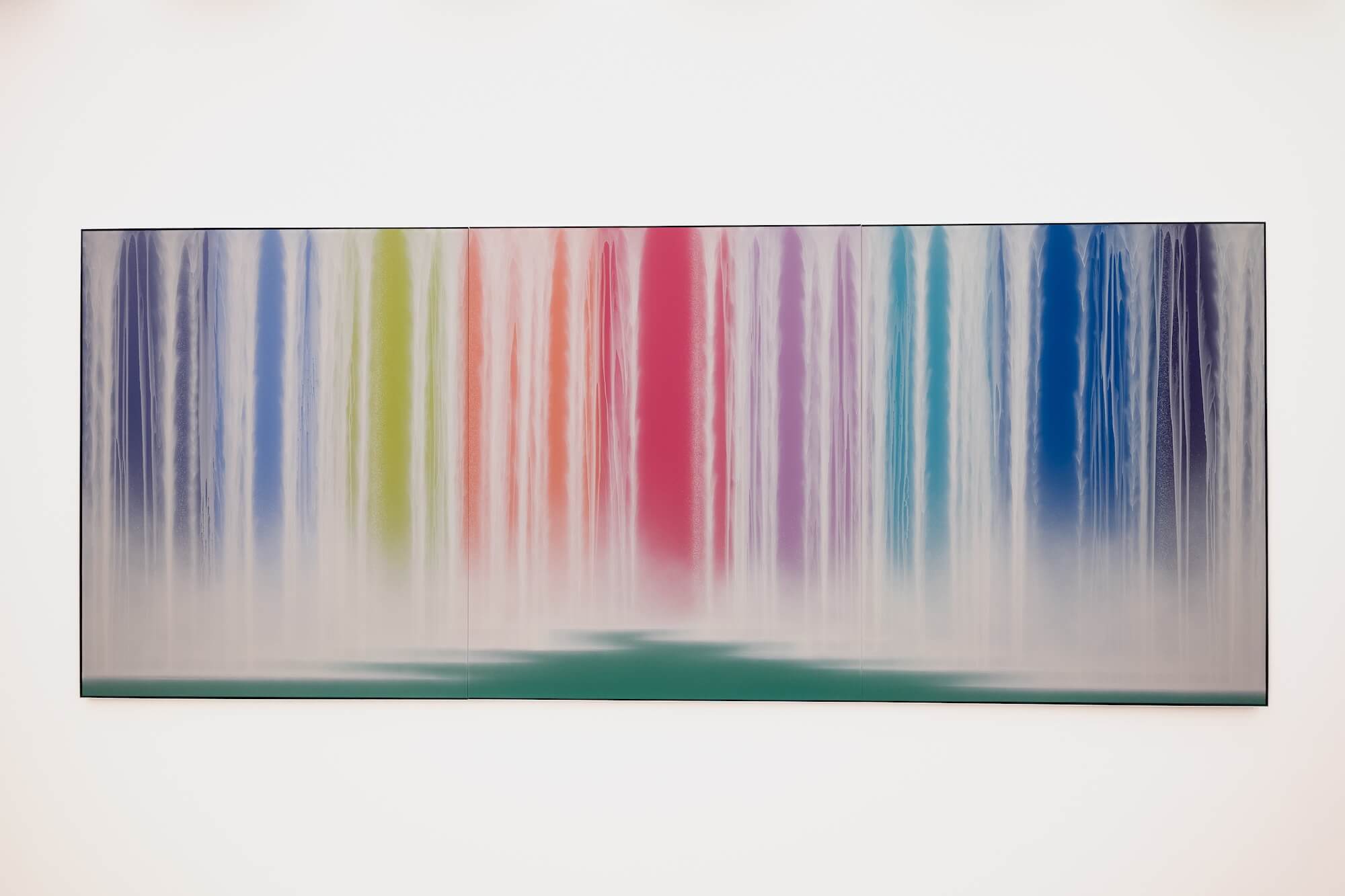
Hiroshi Senju (born 1958)
Waterfall on Colors, 2022
Pigment on Japanese mulberry paper mounted on board
Courtesy of the artist and
Sundaram Tagore Gallery, New York, New York
View Bio
Hiroshi Senju’s paintings bridge aesthetic traditions from his native Japan and postwar abstraction. Senju’s works respond to natural spaces and phenomena, such as waterfalls, yet tend toward abstraction. By using ancient Japanese painting techniques and materials, the artist conveys images and experiences that connects ancient and modern visual language. Senju created his monumental piece Waterfall on Colors in three panels, using pigments derived from natural materials in a medium of animal-hide glue applied to hand-screened Japanese mulberry paper. Senju’s work is in the permanent collections of the Victoria & Albert Museum, London; The Metropolitan Museum of Art and Brooklyn Museum, New York; Los Angeles County Museum of Art and Museum of Contemporary Art, Los Angeles; Asian Art Museum, San Francisco; Nelson-Atkins Museum of Art, Kansas City, Missouri; Royal Ontario Museum, Toronto; Museum of Modern Art, Toyama, Japan; Yamatane Museum of Art, Tokyo; Tokyo University of the Arts; and Kushiro Art Museum, Hokkaido.
Artist website: www.hiroshisenju.com
Gallery website: www.sundaramtagore.com
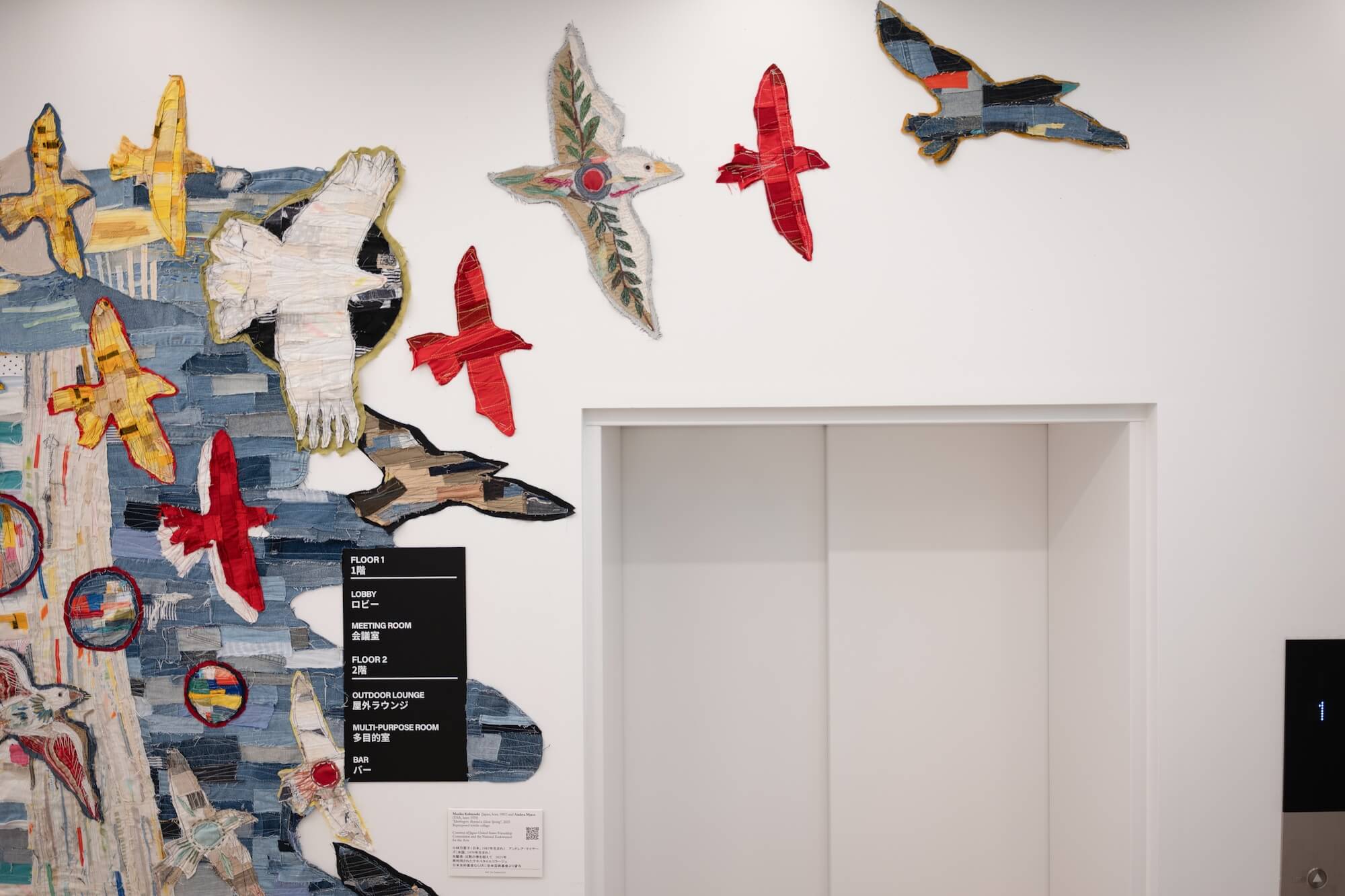
Mariko Kobayashi (Japan, born 1987) and Andrea Myers (USA, born 1979)
"Harbingers: Beyond a Silent Spring”, 2025 Repurposed textile collage
Courtesy of Japan-United States Friendship Commission and the National Endowment for the Arts
View Bio
Japanese textile artist Mariko Kobayashi investigates what it means to be conscious in the present moment in her artwork. Kobayashi is interested in the connection between the physical human body and the earth.
Andrea Myers uses painting, sculpture, sculpture and textiles to explore the space between two and three dimensionality. Myers creates textile collages through a hybridization of quilting, applique, and patchwork methods.
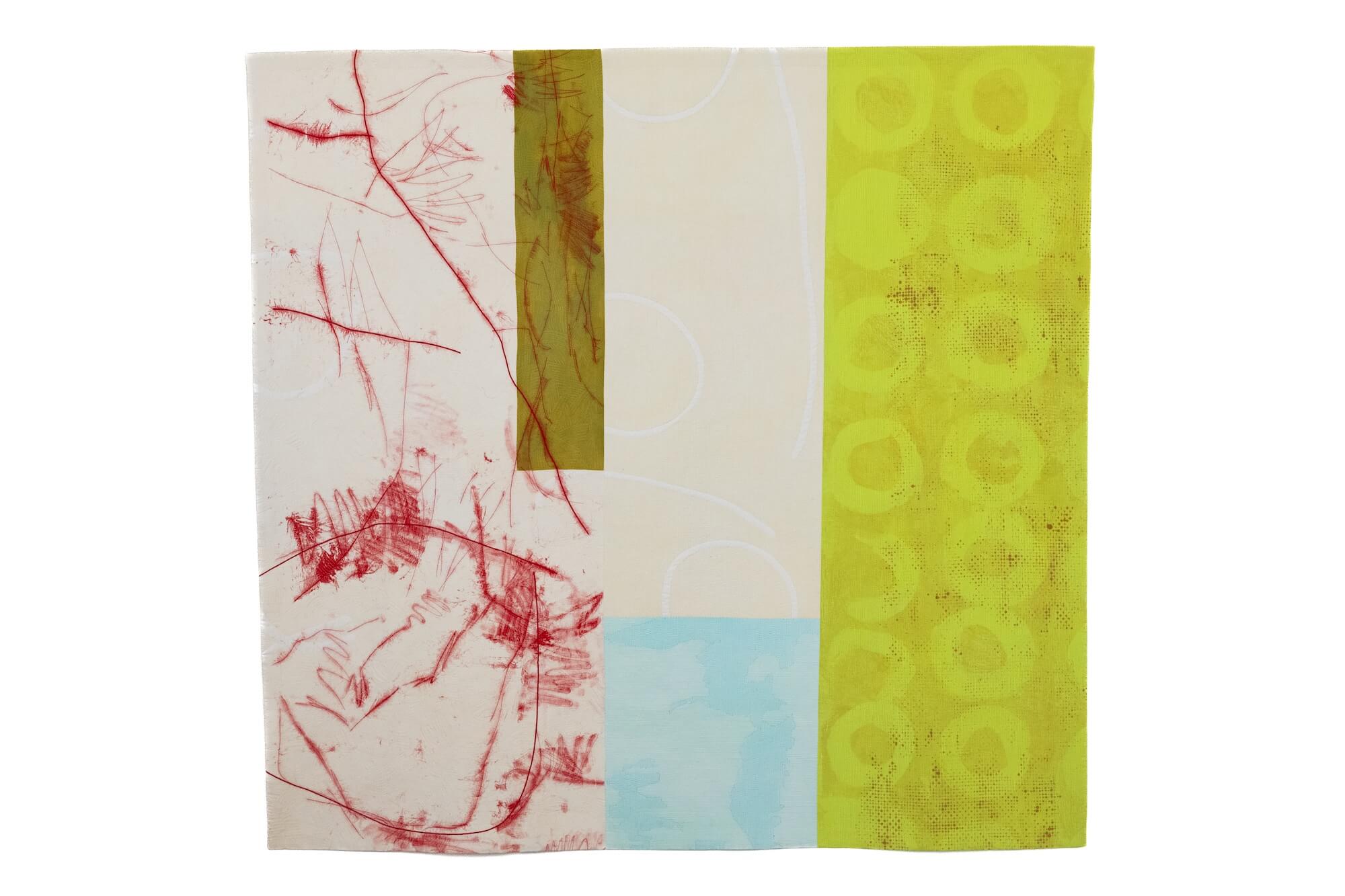
Karen Schulz (born 1954)
Mixed Messages, 2019
Hand dyed cotton fabric, acrylic paint, machine pieced and quilted, couching
Courtesy of the artist, Silver Spring, Maryland
View Bio
Textile artist Karen Schulz references shape, color and texture in her compositions which encourage the viewer to enter and linger within. Schulz has been making quilts for the last 44 years and works almost exclusively in abstraction. The artist custom dyes her fabrics and does all the quilting in her studio in Maryland, transforming the ordinary into the extraordinary. The use of the line in the quilt on display is one of the artist’s signature components in the composition.
Artist website: www.karen-schulz.com

Sharif Bey (born 1971)
Kiwi Teapot, 2025
Saggar-fired earthenware with porcelain shards and mixed media
Courtesy of the artist, Syracuse, New York
View Bio
Ceramicist and professor Dr. Sharif Bey was introduced to ceramics through the community-based Manchester Craftsmen’s Guild apprenticeship program in Pittsburgh when he was in high school. He creates both functional and sculptural pottery, using a variety of forms and textures, exploring the cultural significance of ornamentation and crafts. While Bey’s work Teapot with cross hatching texture showcases his interest in functional pottery, his work Kiwi Teapot is more sculptural, showcasing Bey’s interest in the cultural significance of ornamentation through the vessel’s adornment of porcelain shards. Bey is also an active scholar, publishing in academic journals on art education. Bey’s work is featured in numerous public collections, including the Carnegie Museum of Art, the Smithsonian American Art Museum’s Renwick Gallery, and the Everson Museum of Art, among others.
Artist website: www.sharifbeyceramics.com
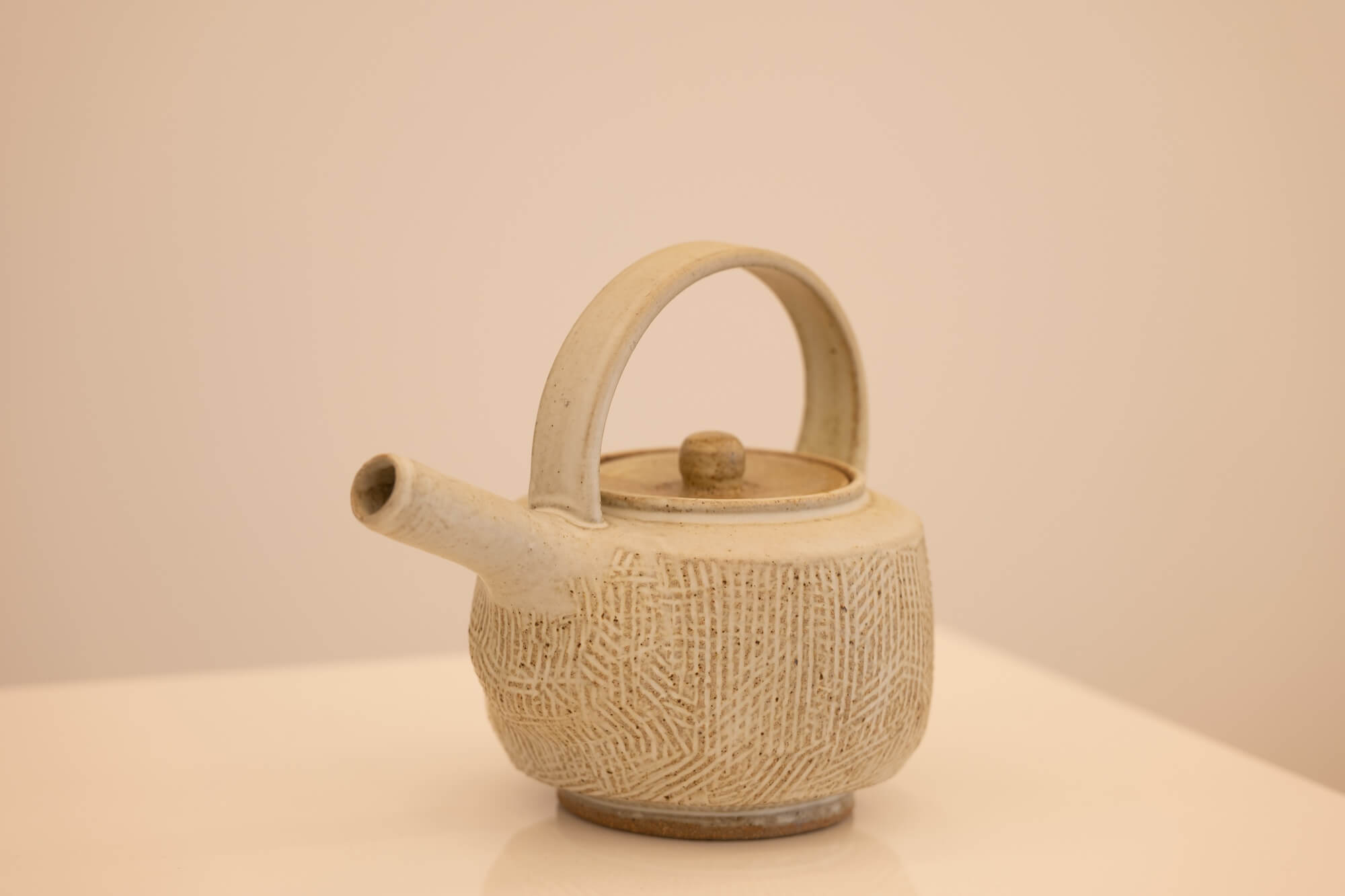
Sharif Bey (born 1971)
Teapot with cross hatching texture, 2016 Stoneware
Courtesy of the artist, Syracuse, New York
View Bio
Ceramicist and professor Dr. Sharif Bey was introduced to ceramics through the community-based Manchester Craftsmen’s Guild apprenticeship program in Pittsburgh when he was in high school. He creates both functional and sculptural pottery, using a variety of forms and textures, exploring the cultural significance of ornamentation and crafts. While Bey’s work Teapot with cross hatching texture showcases his interest in functional pottery, his work Kiwi Teapot is more sculptural, showcasing Bey’s interest in the cultural significance of ornamentation through the vessel’s adornment of porcelain shards. Bey is also an active scholar, publishing in academic journals on art education. Bey’s work is featured in numerous public collections, including the Carnegie Museum of Art, the Smithsonian American Art Museum’s Renwick Gallery, and the Everson Museum of Art, among others.
Artist website: www.sharifbeyceramics.com
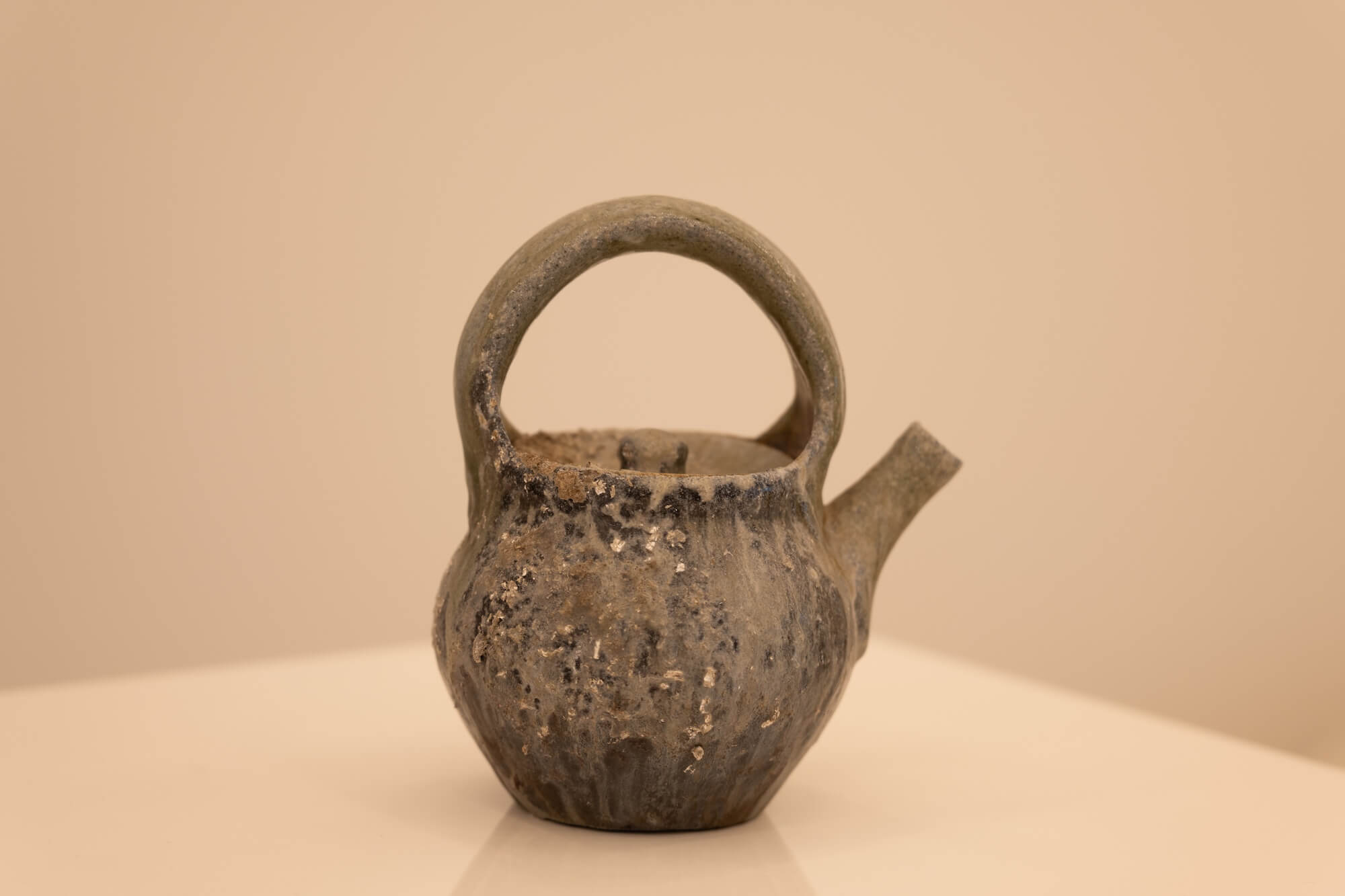
Theaster Gates (born 1973)
Untitled, 2022
High fired stoneware with glaze
Courtesy of the artist, Syracuse, New York
View Bio
Theaster Gates has earned international acclaim for a practice that traverses multiple media and genres, primarily focusing on sculpture and ceramics but also encompassing architecture, music, performance, fashion and design. Trained as a sculptor and urban planner, Gates has been influenced by Japanese craft and culture over the past 20 years. He first traveled to Japan in 2004 to study ceramics in Tokoname, Aichi Prefecture. In his practice, Gates is interested in redeeming spaces and materials that have been left behind. Gates’s stoneware and clay work explores heat, pressure, time, and material accumulation through the form of a vessel as well as the possibility of the “life within things.”. Gates’ works are held in the collections of the Walker Art Center in Minneapolis, the MCA Chicago, the Smithsonian American Art Museum in Washington, D.C., and the Tate in London, among others.
Artist website: www.theastergates.com
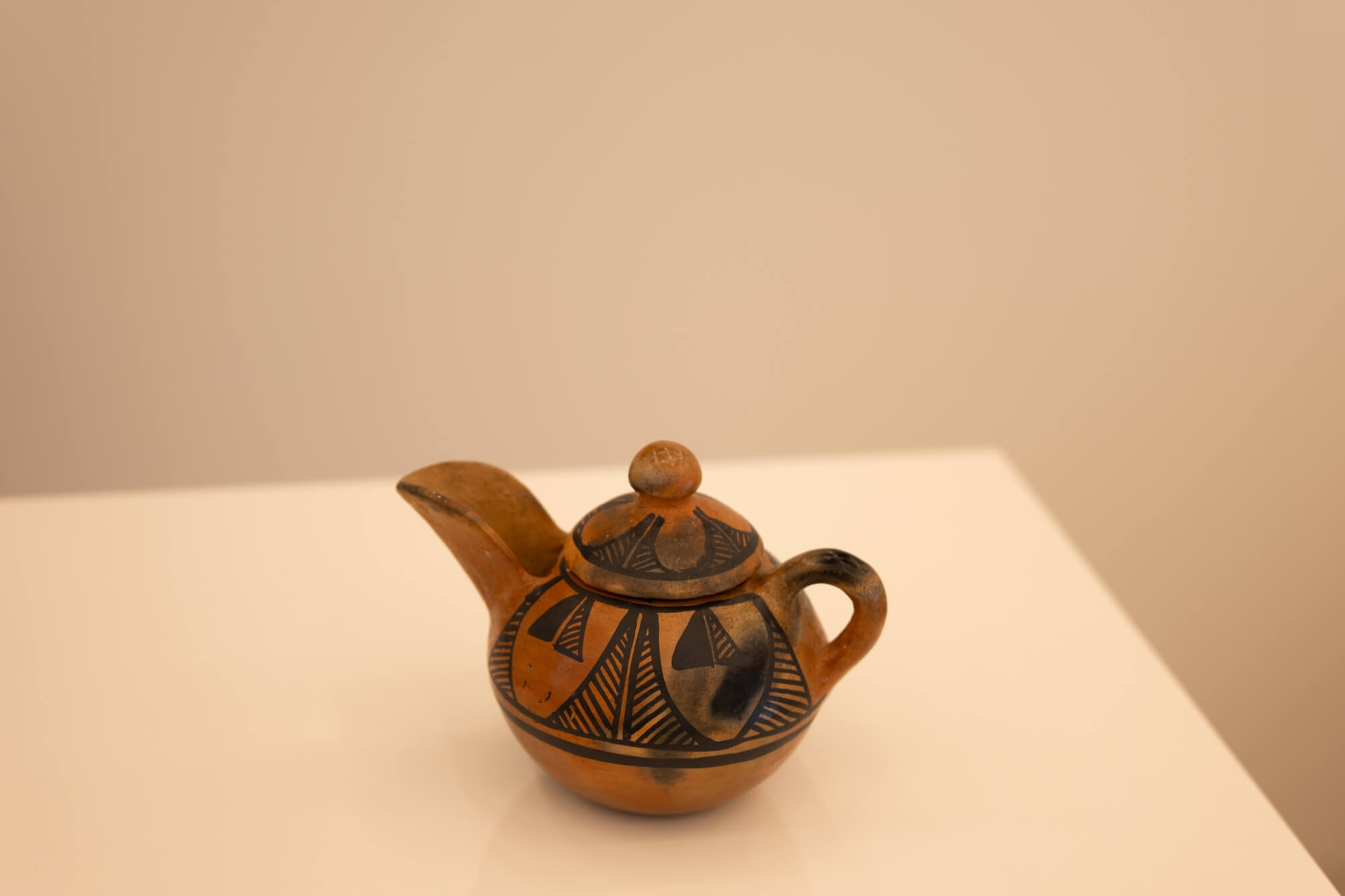
Hopi Tribe, Unknown Artist
Hopi Pueblo Teapot, circa 1920-30
Pit-fired earthenware
Courtesy of the Kamm Teapot Foundation,
Statesville, North Carolina
View Bio
The Hopi Tribe is the westernmost group of Pueblo Native American Indians who have lived for centuries in Northern Arizona. The making of Hopi pottery involves methods of coiling and scraping clay and the use of yucca leaf brushes to paint intricate designs on the vessels. Hopi pottery from the 20th century is heavily influenced by the practices of the prehistoric ancestors of the Hopi People.
Foundation website: https://kammteapotfoundation.org/
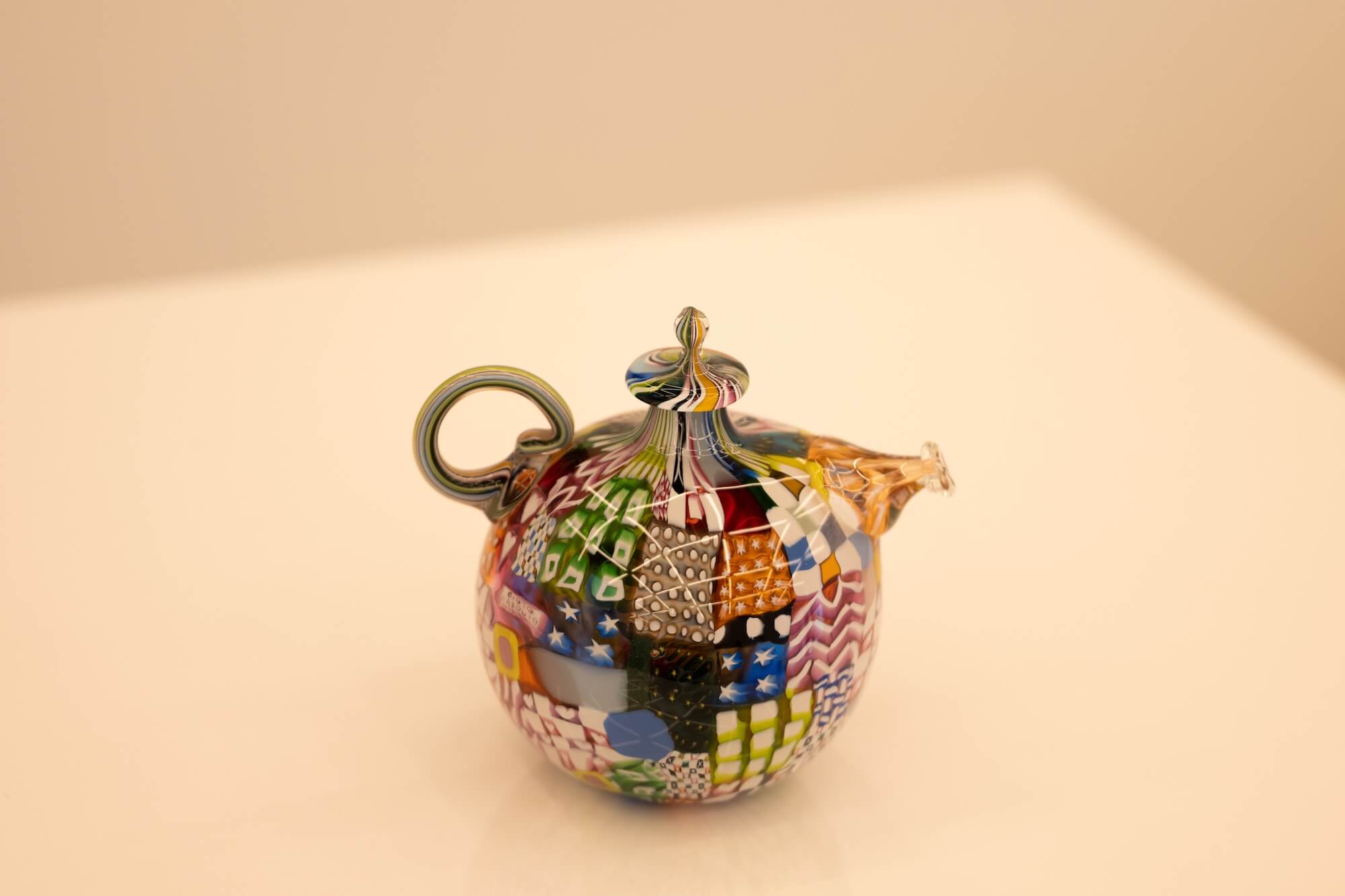
Richard Marquis (born 1945)
Crazy Quilt Teapot #035, 1979
Blown glass
Courtesy of the Kamm Teapot Foundation,
Statesville, North Carolina
View Bio
The Hopi Teapot, Richard Marquis’, Crazy Quilt Teapot and Connie Roberts’, Tea Time, was loaned through the Kamm Teapot Collection started by Los Angeles residents Sonny and Gloria Kamm who have collected teapots for over 35 years. Their passion resulted in the world’s largest and most comprehensive teapot collection. The Kamm Teapot Collection numbers over 17,000 items and runs the gamut from historical decorative arts to industrial design icons to unique works of contemporary art.
Foundation website: https://kammteapotfoundation.org/

Richard Marquis (born 1945)
Teapot, 1980 Glass Courtesy of the artist and R & Company, New York, New York
https://usapavilion.us/wp-admin/
View Bio
Richard Marquis (b.1945, Bumble Bee, Arizona)
Richard Marquis is a glass artist who is known for his groundbreaking use of ancient Venetian glass blowing techniques. In the late 1960s he was the first American to be permitted to blow glass in the Venini Factory in Murano. Italy. Marquis is interested in creating works that can communicate and resonate with any viewer, which is why his blown glass pieces often reference Americana and other recognizable motifs.
Marquis’ work can be found in institutions across the globe including the Los Angeles County Museum of Art, the New Orleans Museum of Art, the Metropolitan Museum of Art and Museum of Arts & Design, New York, the Smithsonian American Art Museum, Washington DC; Victoria and Albert Museum, London, England; New Glass Museum, Tsukuba, Japan; and the Muséedes Arts Décoratifs, Lausanne, Switzerland, to name a few.
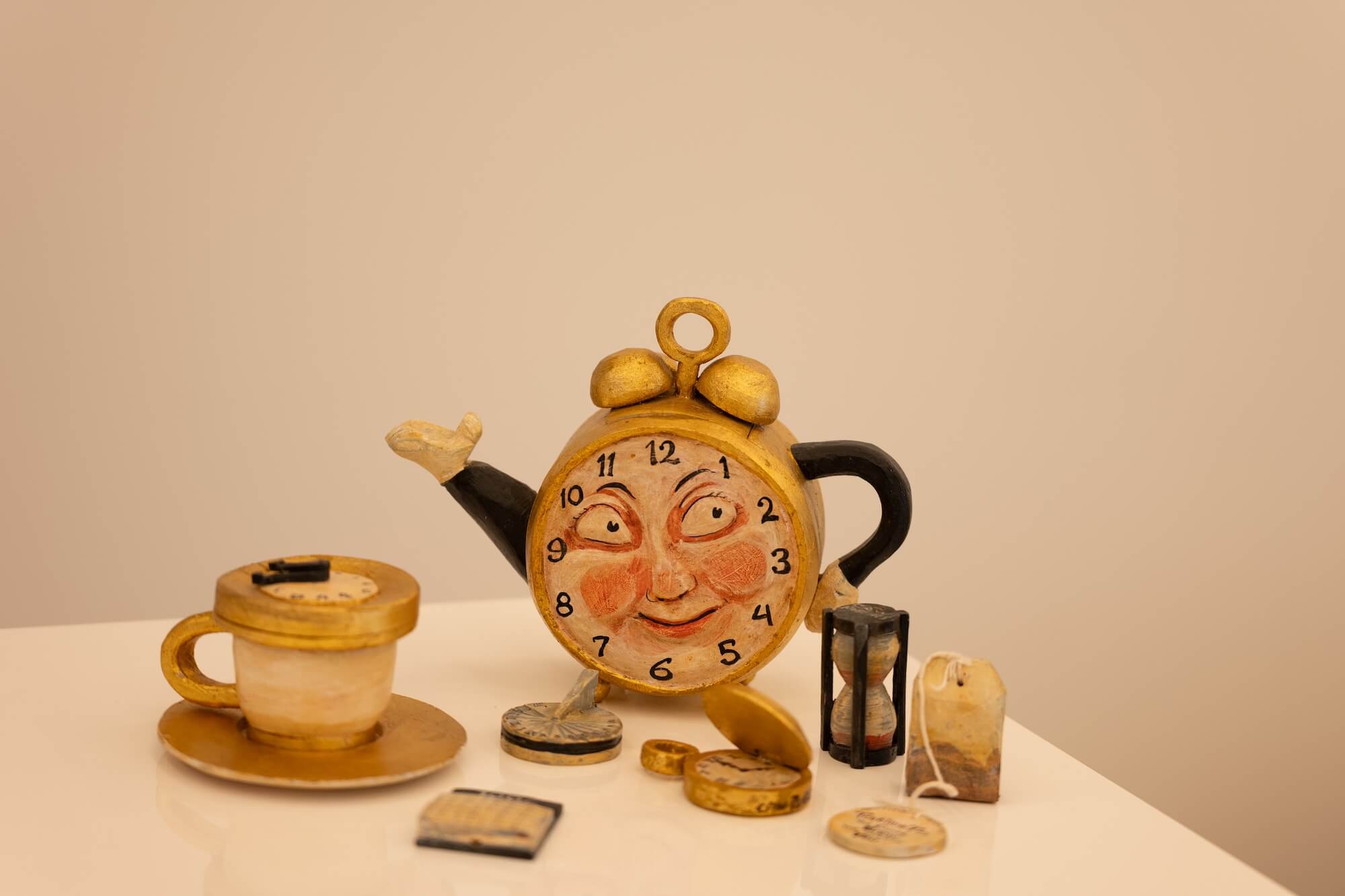
Connie Roberts (born 1949)
Tea Time, 1996
Carved and painted wood
Courtesy of the Kamm Teapot Foundation,
Statesville, North Carolina
View Bio
Connie Roberts (American, b.1949)
Iowa-based artist “Connie” Constance Alyce Roberts bridges the gap between folk and fine art in her wood carvings. Her pieces take influence from nursery rhymes, and cartoons. Tea Time is carved and fabricated sculptural tea set, made of wood that has been painted with gold leaf accents. The teapot is modeled as an old-fashioned alarm clock with a black spout and handle, each terminate in a white gloved hand. The smaller pieces are modeled as time related objects: a sundial, hourglass, calendar, pocket watch, and teabag with label “”Teatime Tea””. All pieces (except the teapot, lid and saucer) function as whistles with carved openings to produce the sound of tea kettle whistle.
Foundation website: https://kammteapotfoundation.org/

Roberto Lugo (born 1981)
The Wave Revisited, 2025
Glazed ceramic and luster
Courtesy of the artist, Philadelphia, Pennsylvania and R & Company, New York, New York
View Bio
Philadelphia-based artist, ceramicist, poet, and educator Roberto Lugo uses classical European and Asian ceramic techniques as a way to connect and communicate using the vessels of a teapot which people understand but incorporating visual information from his experiences to initiate and expand conversation. The Wave Revisited is inspired by The Great Wave, from the series Thirty-six Views of Mount Fuji by artist Katsushika Hokusai (Japanese, Tokyo (Edo) 1760–1849).
His work is found in the permanent collections of the Los Angeles County Museum of Art, the Philadelphia Museum of Art, The Metropolitan Museum of Art, The High Museum of Art, the Museum of Fine Arts Boston, the Brooklyn Museum, the Walters Art Museum, and more.
Artist website: www.robertolugostudio.com
Gallery website: www.r-and-company.com
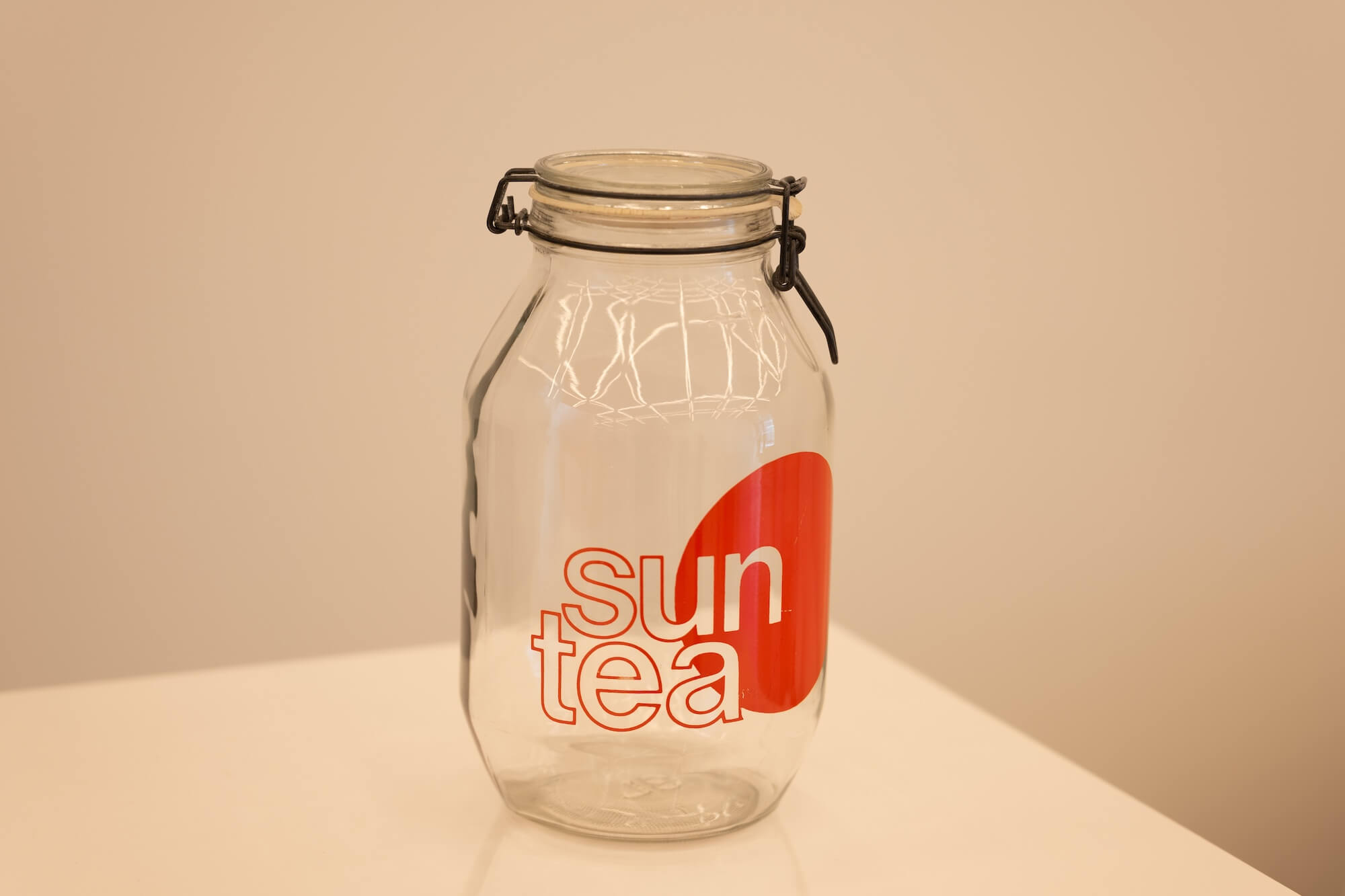
Sun Tea, circa 1970s
3-liter bale top glass container
Collection of Art in Embassies, Washington D.C.
View Bio
Sun tea, or tea brewed with the heat of the sun, was incredibly popular in the southern United States in the 1970s as a way to easily brew tea in the summer. The making of sun tea required leaving a glass container—like the Sun Tea Jar—in the sun for a few hours with tea bags. This provided a refreshing and simple beverage to drink in the warm months.

Rochester Stamping Works Metal Pitcher, circa early 20th century Metal
Untitled
Collection of Art in Embassies, Washington D.C.
View Bio
Rochester Stamping Works was founded in 1888 in Rochester, New York by Yale graduate Albert Pritchard. Rochester Stamping Works, later renamed Rochester Stamping Company, manufactured high-quality sheet metal goods including tea kettles, tea and coffee pots, oyster pails and metal packages for tobacco.
